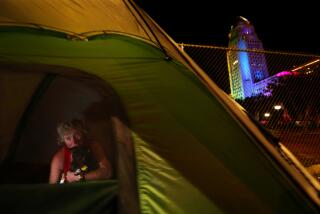Garcetti pitches ‘rewards’ for neighborhoods that accept homeless shelters
Mayor Eric Garcetti wants to “reward” Los Angeles neighborhoods that accept temporary homeless shelters by performing more encampment sweeps in those communities than in areas resistant to the housing.
The mayor’s proposal, to be announced in his State of the City speech Monday, would pay for additional city cleaning crews and police services in communities that agree to find room for trailers, tents and other shorter-term shelter for people living on the street.
“I will give rewards to those communities that say yes first,” Garcetti said in an interview last week. “They’ll get more help cleaning up. They’ll get more funds. The first people to step up and say, ‘We do want to solve this in our own neighborhood,’ will see those funds flow first.”
The proposal comes as Garcetti and City Council members want to overcome the not-in-my-backyard battles over homeless services or shelters that have erupted in Venice, San Pedro and, more recently, Orange County.
Garcetti’s proposed budget for the next fiscal year, expected to be released Thursday, allocates $20 million for temporary shelters in the city’s 15 council districts.
That money would be divided equally, with each district to receive about $1.3 million. But City Council members would lose that money if it isn’t committed by January 2019 to be spent on shelters, which could consist of trailers, large tents, unused buildings or “safe parking” programs.
If a City Council member doesn’t commit the money by January, the funds would go back into a pool that other City Council members can use to pay for shelters.
To smooth the way for the shelters, the mayor plans to sign an emergency shelter declaration Tuesday that would loosen zoning rules, allowing for quick construction, Garcetti’s deputy chief of staff Matt Szabo said Friday.
“We have no intention to force projects on any district or in any location, but we are confident that there is sufficient consensus that we need these projects,” Szabo said. “Everybody has to be part of the solution.”
Garcetti, who was in Iowa over the weekend as he considers a presidential run, wants to end street homelessness by 2028 and halve the unsheltered population in next five years. The city and the county are beginning to spend the voter-approved funds on new homeless housing and services, but there is growing urgency to help the city’s unsheltered population, which stands at 25,237, according to the latest count.
There is also mounting frustration with the tents and tarps that dot the city sidewalks, freeway underpasses and alleyways. A program to clean encampments had nearly 6,000 pending requests through early February.
City Council members will debate Garcetti’s shelter proposal in the coming weeks.
The city is still discussing the plan with the county, which would help oversee services at the shelters, Szabo said. The goal is to shelter up to 100 people in each district, either at one location or several sites. Homeless-service providers are more successful placing people in shelters in areas where they already live, he said.
Separately, the city has set a goal of building 222 new permanent supportive housing units in each council district.
The shelter program is modeled after Garcetti’s planned trailer compound on a city-owned parking lot near Olvera Street. The trailers are scheduled to open this summer and hold beds, toilets, showers, and mental health services.
Szabo said the city will try to prevent street encampments from forming again in communities that agree to host the new shelters. “We won’t allow for reencampment in those targeted areas.”
The encampment cleanups are controversial, with homeless people complaining that their belongings have been taken away. Officials say the sweeps are necessary to protect against diseases, including hepatitis A, and to keep public walkways clear.
Under the mayor’s proposal, neighborhoods that accept shelters would get extra sanitation crews and HOPE teams. The Homeless Outreach and Proactive Engagement teams, led by the LAPD, offer shelter and services to camp residents.
Stuart Waldman, president of the business group Valley Industry and Commerce Assn., praised the mayor’s homelessness goals but questioned whether neighborhoods would support the plan.
“We have trouble getting community support for 100-unit apartment buildings, so I can’t imagine them supporting camps that size,” Waldman said.
Councilman Mike Bonin said the mayor’s proposal marks a “significant financial investment” to get people off the street, and a shift in city strategy. “The only way to reduce encampments is to provide alternatives,” he said. “It’s either shelter or sidewalks.”
The city has an alarming lack of shelters for the street population, Szabo said.
“There is virtually nothing available on the Westside, there is virtually nothing available in the Valley, each and every night. If there is any availability, it’s generally in the skid row area,” he said.
Garcetti’s proposed budget for fiscal year 2018-19 also allocates $429 million toward homelessness, compared with about $180 million budgeted last year.
The majority of the increase is revenue from Proposition HHH, a voter-backed bond measure to fund the construction of permanent supportive housing.
Times staff writer Liam Dillon contributed to this report.
Twitter: @dakotacdsmith
More to Read
Sign up for Essential California
The most important California stories and recommendations in your inbox every morning.
You may occasionally receive promotional content from the Los Angeles Times.










